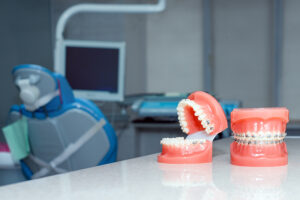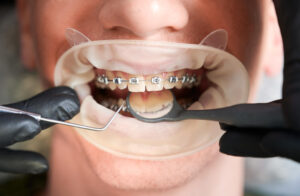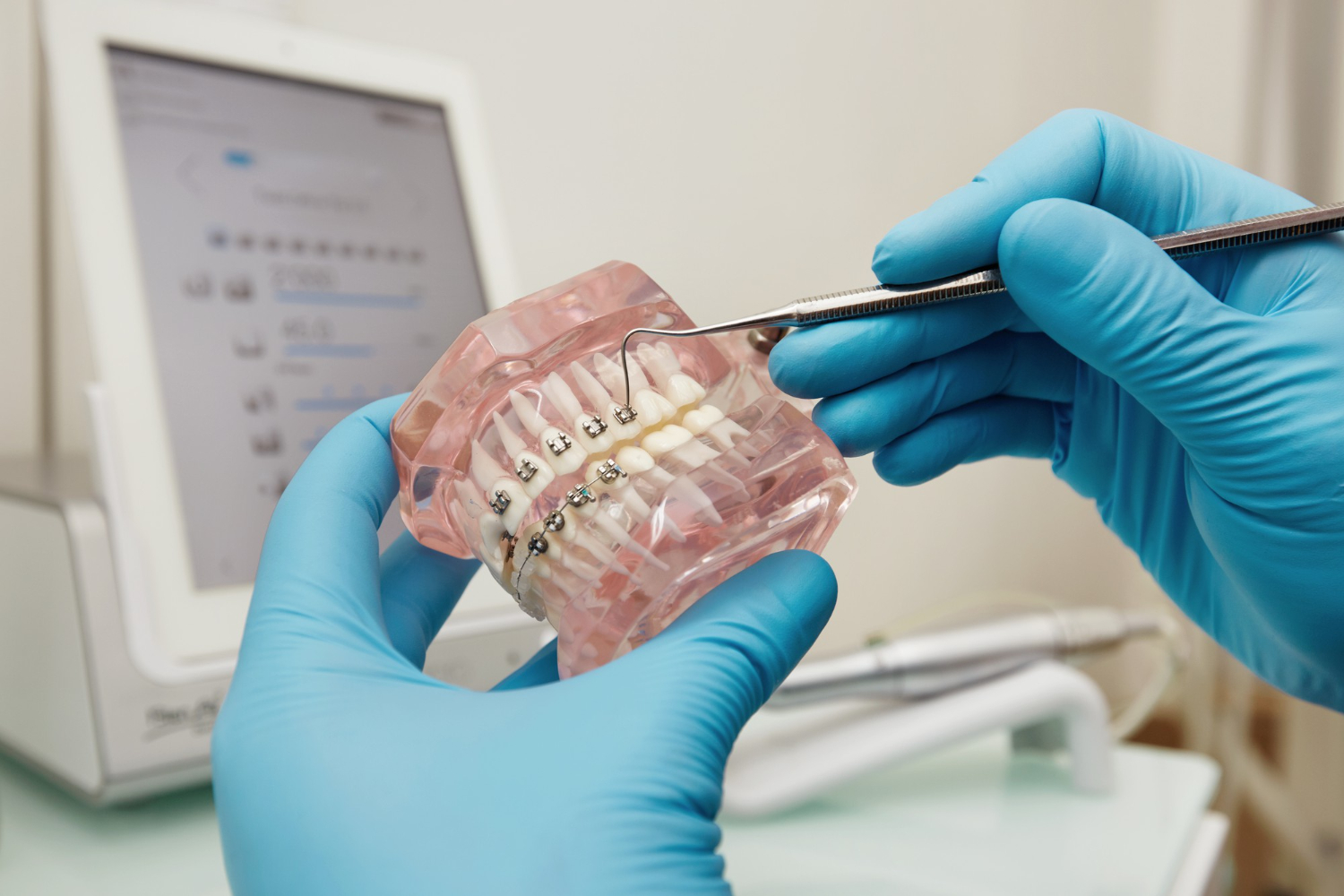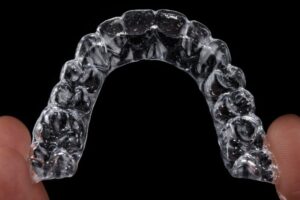Braces are more than just a dental device. They are a critical tool in orthodontics that corrects a wide range of dental issues, such as misaligned teeth and bite problems. How do braces work? Having a clearer understanding of the mechanics and benefits involved with braces will help you make informed decisions about your or your family’s orthodontic care.
What Are Braces?

Braces are devices used in orthodontics that align and straighten teeth while also aiming to improve dental health. They correct issues such as crooked teeth, overbites, underbites, crossbites, and various other flaws of the teeth and jaw. Braces can be necessary for both functional and aesthetic reasons, contributing to better chewing functionality and the longevity of natural teeth.
History of Braces
The concept of orthodontics dates back thousands of years, but modern braces were developed in the early 19th century. The evolution of braces has moved from bulky metal bands wrapped around each tooth to much sleeker and more comfortable designs that are common today. This progression reflects ongoing advancements in dental science and technology, aimed at improving patient comfort and treatment effectiveness.
Components of Braces
Braces consist of several key components that work together to apply continuous pressure over a period of time to slowly move teeth in specific directions. Here’s a breakdown of these components:
- Brackets: These are small squares that are bonded directly to the front of each tooth with a dental bonding agent. They serve as the handle, holding the arch wires that move the teeth. The brackets can be metal or made from a clear ceramic material.
- Orthodontic Bands: These are not used for all patients, but where they are necessary, they wrap around the teeth to anchor other components securely.
- Arch Wires: Attached to the brackets, these wires guide the movement of the teeth. Arch wires can be made of metal or be clear to be less noticeable.
- Ties: Small rubber rings or fine wires that fasten the arch wire to the brackets. They can be clear, metal, or colored, depending on personal preference.
- Buccal Tubes: These are attached to the band on your last tooth which helps to hold the end of the arch wire securely in place.
- Spacers: These are separators that fit between teeth to create a small space prior to the placement of orthodontic bands.
Types of Braces
When it comes to choosing braces, there are several types available, each designed to cater to different orthodontic needs and lifestyle preferences. Here’s an overview of the most common types of braces used today:
Traditional Metal Braces
Traditional metal braces are the most widely recognized type of braces. They consist of high-grade stainless steel and are known for their strength and durability. Metal braces are the most effective at treating extreme overcrowding of teeth and can be a cost-effective option. The modern versions are much smaller and less conspicuous than the older models, and patients can customize them with different colored ties for a more unique and personal look.
Ceramic Braces
Ceramic braces offer a less-visible alternative to metal braces because they use tooth-colored or clear ceramic brackets that blend more naturally with the teeth. They perform the same function as metal braces but are more aesthetic, making them a popular choice among adults and older teenagers who are conscious about the appearance of braces. While ceramic braces are less noticeable, they require more attention to oral hygiene as they are larger and more brittle than their metal counterparts.
Lingual Braces
Lingual braces are similar to traditional metal braces but with a unique twist: the brackets and wires are placed on the inside surfaces of the teeth. This positioning makes them virtually invisible from the outside, providing an excellent aesthetic option for those who prefer their dental treatment to remain private. However, lingual braces can be more challenging to clean, and not everyone is a candidate for this type of braces as they require a particular alignment and spacing of the teeth.
Clear Aligners (e.g., Invisalign)
Clear aligners are a series of custom-made, removable appliances that replace traditional braces. Brands like Invisalign use transparent plastic trays that fit snugly over the teeth and gradually move them into position. These aligners are virtually invisible and can be removed for eating, drinking, brushing, and flossing, offering a highly flexible and discrete treatment option. They are best suited for adults and teens with mild to moderate orthodontic issues. However, the success of clear aligners depends heavily on the patient’s commitment to wearing them as directed—typically 22 hours a day.
How Braces Work
Understanding the mechanics of how braces move teeth is fundamental to appreciating the entire treatment process. Braces apply continuous pressure over an extended period, which slowly moves teeth into their ideal positions. Here’s a closer look at the biomechanics involved and the phases of treatment.
Biomechanics of Braces
How do braces work? The key to how braces work lies in the gentle but persistent pressure they apply to the teeth. This pressure is transmitted via the archwire through the brackets and bands attached to the teeth. When pressure is applied to the teeth, it causes the periodontal membrane—the tissue that surrounds and supports the teeth—to stretch on one side and compress on the other. This biomechanical process triggers the bone in the jaw to adapt, allowing teeth to move gradually.
How do braces work? As the bone adjusts, osteoclasts (bone-resorbing cells) break down the bone in the path of the moving tooth, while osteoblasts (bone-forming cells) work to rebuild the bone behind it. This remodeling of the bone is what allows the tooth to shift into its new position securely.
Phases of Treatment
Orthodontic treatment with braces generally involves several phases:
- Initial Alignment: During the first few months, the focus is on correcting the visible misalignment of teeth. This phase often yields the fastest and most dramatic changes in appearance.
- Space Closing: Following alignment, braces work to close any gaps between the teeth. This phase may involve different types of wires to ensure that teeth move correctly and efficiently.
- Bite Correction: In this phase, the orthodontist adjusts the position of the teeth to achieve proper alignment of the bite. This is crucial for ensuring that the upper and lower teeth fit together comfortably.
- Detailing and Finishing: The final adjustments are made to ensure each tooth is in the perfect position. This phase may involve fine-tuning the wires and possibly using additional appliances, such as rubber bands, to refine the bite and the overall appearance.
- Retention: Once the active phase of wearing braces is complete, it is essential to maintain the results. Retainers are worn as directed by the orthodontist to keep the teeth in place and prevent them from reverting to their original positions.
Timeline for Braces
The total time braces need to be worn varies widely depending on the individual’s age, the complexity of their dental issues, and how well they comply with their orthodontist’s instructions. Generally, braces are worn for about one to three years. Patients will typically see their orthodontist every 4 to 8 weeks for adjustments that advance the treatment.
Benefits of Braces
How do braces work for patients who wear them? Braces are a significant investment in one’s dental health and appearance. Beyond the obvious benefit of straighter teeth, there are several important advantages that braces offer. Understanding these benefits can help justify the effort and expense involved in undergoing orthodontic treatment. Here are the key benefits of wearing braces:
Health Benefits

- Improved Oral Hygiene: Straight teeth are easier to clean than crooked or misaligned teeth. Fewer crevices and awkward spaces mean there’s less room for plaque and food particles to accumulate. This reduces the risk of cavities, and periodontal disease, and can lead to better overall oral health.
- Decreased Risk of Tooth Damage: Misaligned teeth are more prone to chips and breaks. Correct alignment distributes biting pressure across all teeth, which decreases the likelihood of damage and can prolong the lifespan of your natural teeth.
- Enhanced Digestive Health: Properly aligned teeth improve chewing efficiency, which is the first step in the digestive process. This can help alleviate or prevent digestive disorders associated with poor chewing.
Aesthetic Improvements
- Enhanced Smile: The most visible and often the most exciting benefit of braces is a more attractive smile. This aesthetic improvement can boost self-esteem and improve one’s social interactions.
- Facial Symmetry: Braces can help adjust the alignment of the teeth and jaw, which can subtly alter the overall appearance of one’s face, often enhancing symmetry and balance.
Psychological Impact
- Boosted Confidence: A straight smile often enhances self-confidence. Many people feel more positive about their appearance after the treatment. This can lead to improvements in various aspects of their lives, including social, academic, and professional interactions.
- Improved Social Perceptions: Studies show that people often judge others based on their appearance, including their smiles. Straight teeth are typically perceived as more attractive, leading to better first impressions and improved social experiences.
Caring for Braces
Maintaining good oral hygiene is crucial when wearing braces. Proper care not only helps in achieving the best results but also prevents potential complications such as tooth decay or gum disease. Here are essential tips on how to care for your braces effectively:
Cleaning Techniques
- Brushing: It’s advisable to brush your teeth after every meal and snack to remove food particles and plaque. Use a soft-bristled toothbrush or an orthodontic brush designed to clean around braces. Start by brushing at the gum line at a 45-degree angle, then above and below each bracket. Be thorough yet gentle to avoid damaging the wires and brackets.
- Flossing: Flossing with braces takes more time and patience. Use a floss threader or orthodontic floss to get the floss under the archwire. Gently clean the sides of the teeth and under the gums. Water flossers can also be a helpful tool to remove debris and plaque around the braces and between the teeth.
- Interdental Brushes: These tiny brushes are perfect for removing larger food particles that can get caught in the braces. They can be used for a quick clean in areas that are harder to reach with regular floss.
Foods to Avoid
- Hard Foods: Avoid hard foods such as nuts, hard candies, and ice, as these can break or damage the wires and brackets of the braces.
- Sticky Foods: Chewy candies, gum, and other sticky foods can get caught in braces and pull them away from the teeth, potentially extending treatment time.
- High-Sugar Foods: Minimize the consumption of sugary foods and drinks, as they increase the risk of plaque buildup, which can lead to tooth decay.
Handling Emergencies
- Loose Brackets or Bands: If a bracket or band becomes loose, cover it with dental wax to prevent irritation and contact your orthodontist for a repair appointment.
- Poking Wires: Occasionally, a wire might break and poke into the cheek. Use the eraser end of a pencil to carefully push the wire flat against the tooth. If this isn’t possible, cover it with dental wax and contact your orthodontist.
- Lost Separators: It is common for separators to fall out before the next appointment, especially if they have done their job of creating enough space between the teeth. However, if a separator falls out shortly after it was placed, call your orthodontist.
Choose Wildflower Orthodontics for Your Smile
At Wildflower Orthodontics, we believe every smile is unique and deserves personalized care. Led by Dr. Joseph Giasi, a top graduate of Columbia University, our team is dedicated to providing expert orthodontic services in a warm, welcoming environment. We’re not just about straightening teeth—we boost confidence and enhance smiles.
Our local, patient-focused practice in Round Rock and Pflugerville offers affordable, top-notch braces services, ensuring that everyone can achieve the smile they’ve always wanted.
Discover more about our braces services and begin your journey to a radiant smile, contact us today!






